Abstract
1. This study examined the in vitro and in vivo inhibitory effects of diphenyleneiodonium (DPI), a novel inhibitor of nitric oxide (NO) synthase, on endothelium-dependent vasodilatations. 2. DPI (3 x 10(-8)-3 x 10(-6) M) concentration-dependently inhibited acetylcholine (ACh)-induced relaxation in preconstricted rat thoracic aortic rings, with an IC50 of 1.8 x 10(-7) M and a maximal inhibition of nearly 100%. DPI (3 x 10(-6) M) also completely inhibited the relaxation induced by the calcium ionophore, A23187 but not by sodium nitroprusside (SNP). The inhibitory effect of DPI (3 x 10(-7) M) on ACh-induced relaxation was prevented by pretreatment with NADPH (5 x 10(-3) M) and FAD (5 x 10(-4) M) but not L-arginine (L-Arg, 2 x 10(-3) M). Pretreatment with NADPH did not alter the inhibitory effect of NG-nitro-L-arginine on ACh-induced relaxation. 3. The inhibitory effect of DPI on ACh-induced relaxation in the aortae lasted > 4 h after washout. In contrast to pretreatment, post-treatment (1 h later) with NADPH (5 x 10(-3) M) reversed only slightly the inhibitory effect of DPI. 4. In conscious rats, DPI (10(-5) mol kg-1) inhibited the depressor response to i.v. infused ACh, but not SNP. However, it caused only a transient pressor response which was previously shown to be due completely to sympathetic activation. 5. Thus, DPI is an efficacious and 'irreversible' inhibitor of endothelium-dependent vasodilatation in vivo and in vitro.(ABSTRACT TRUNCATED AT 250 WORDS)
Full text
PDF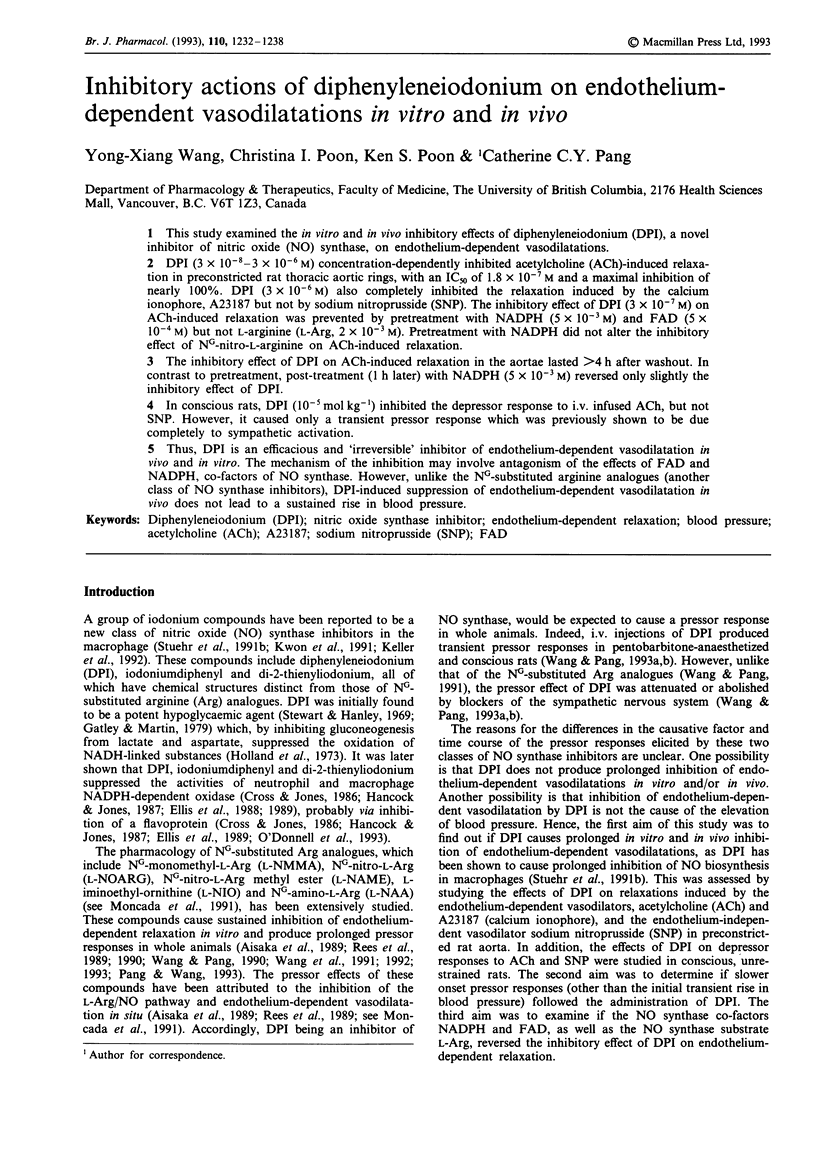
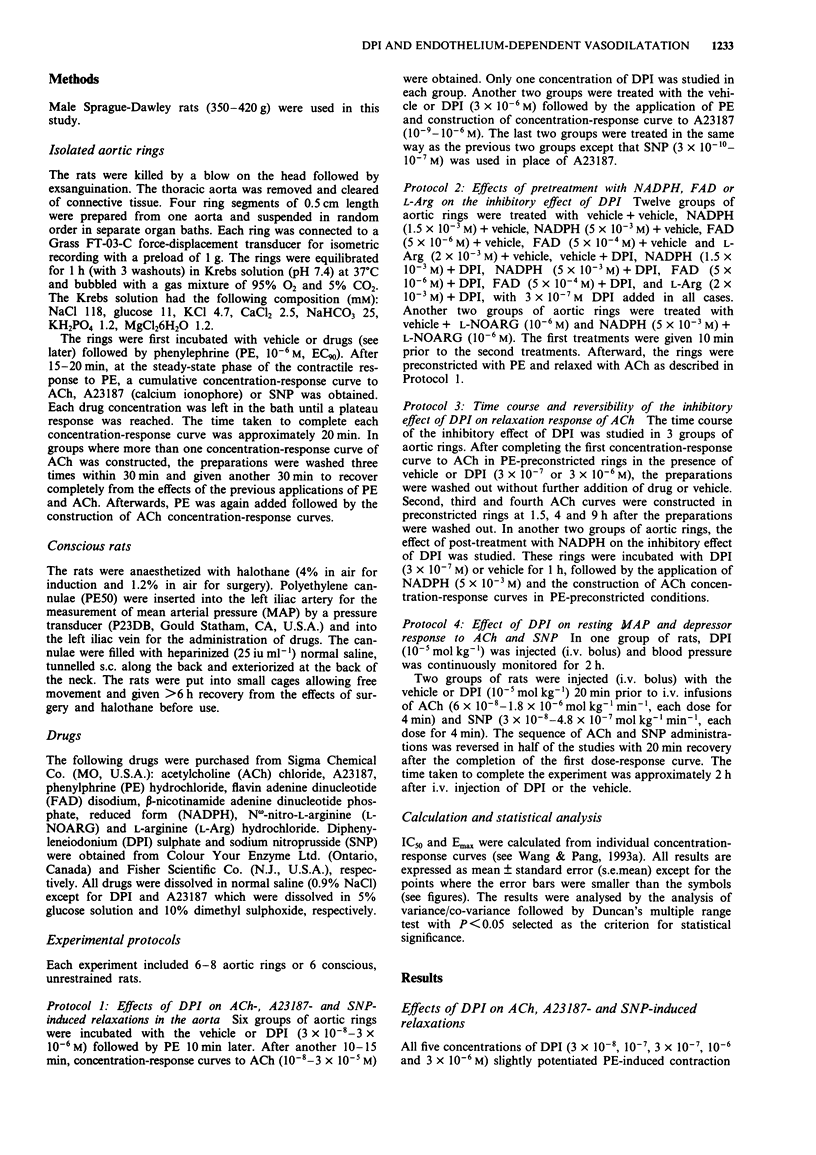
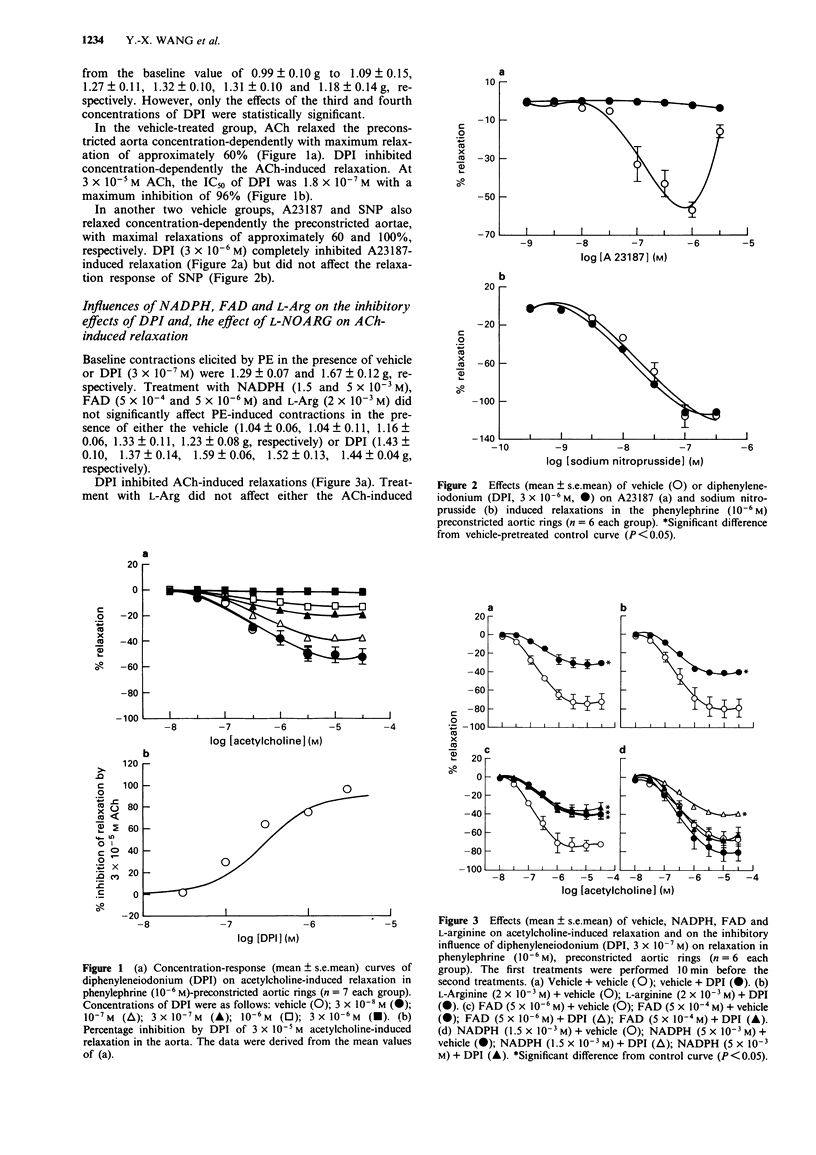
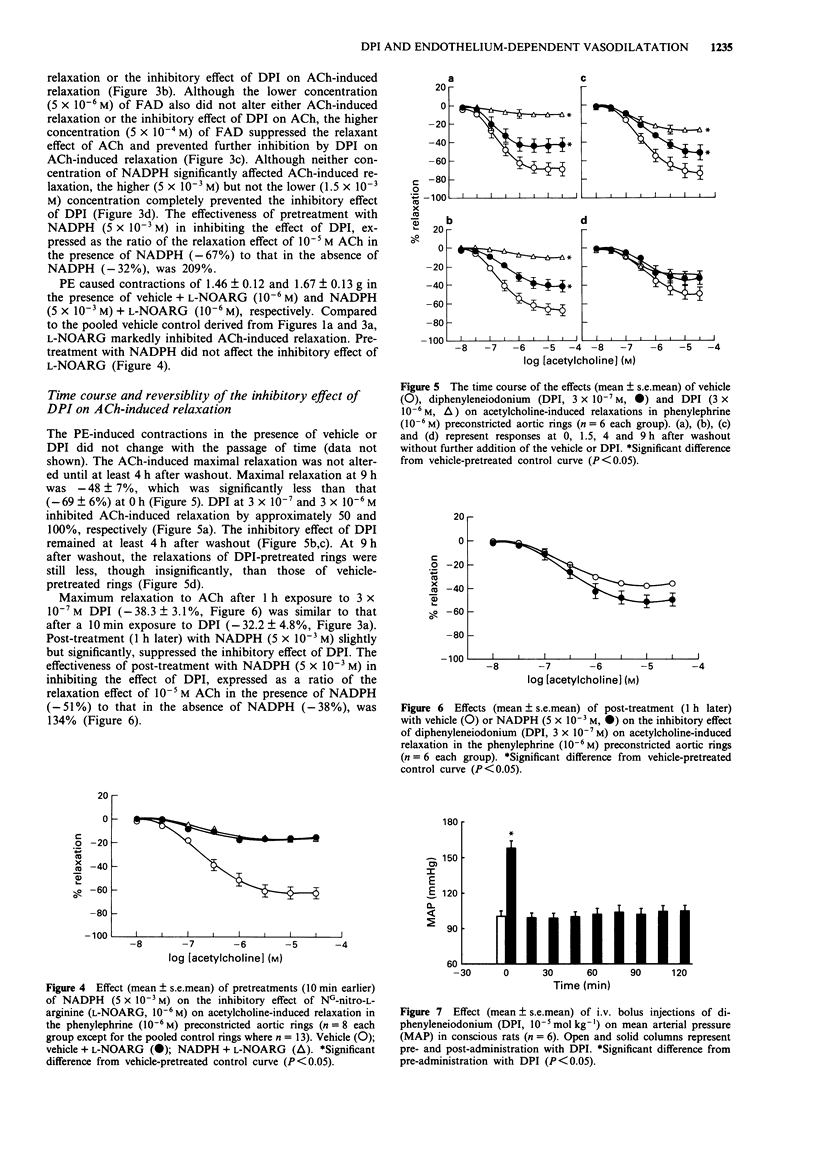
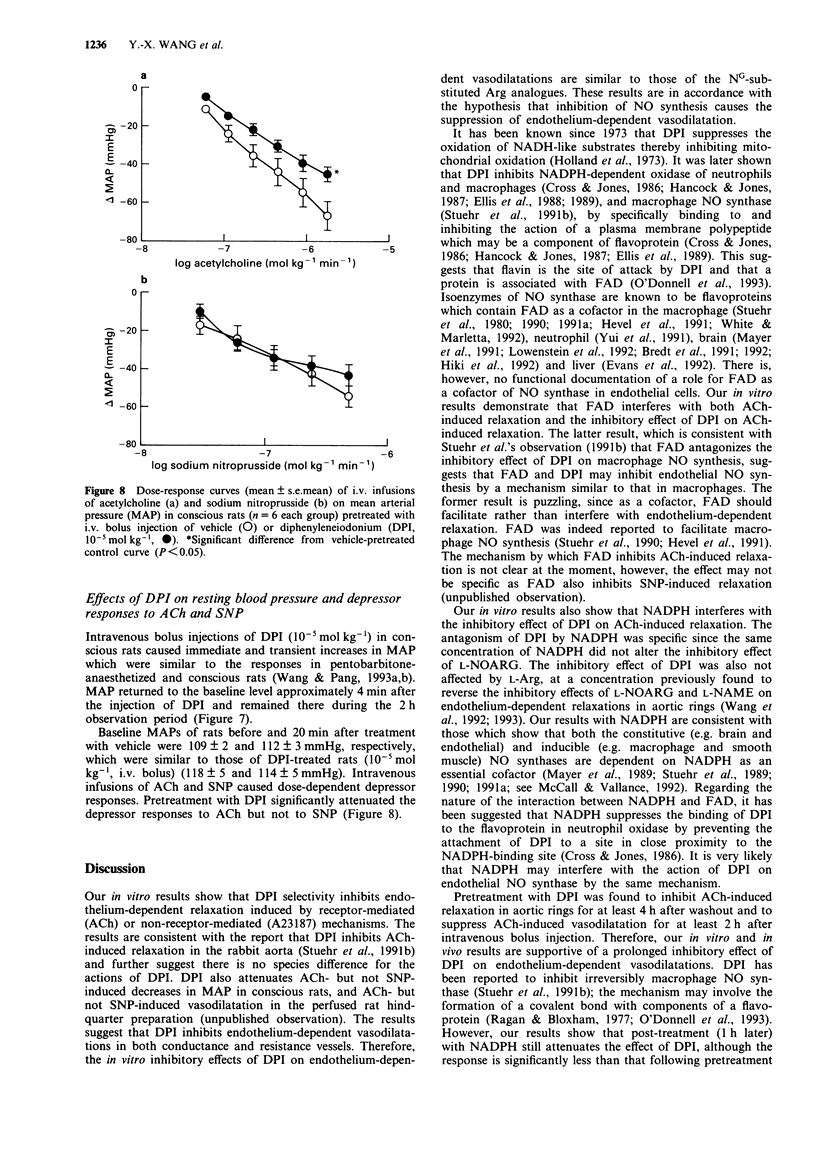
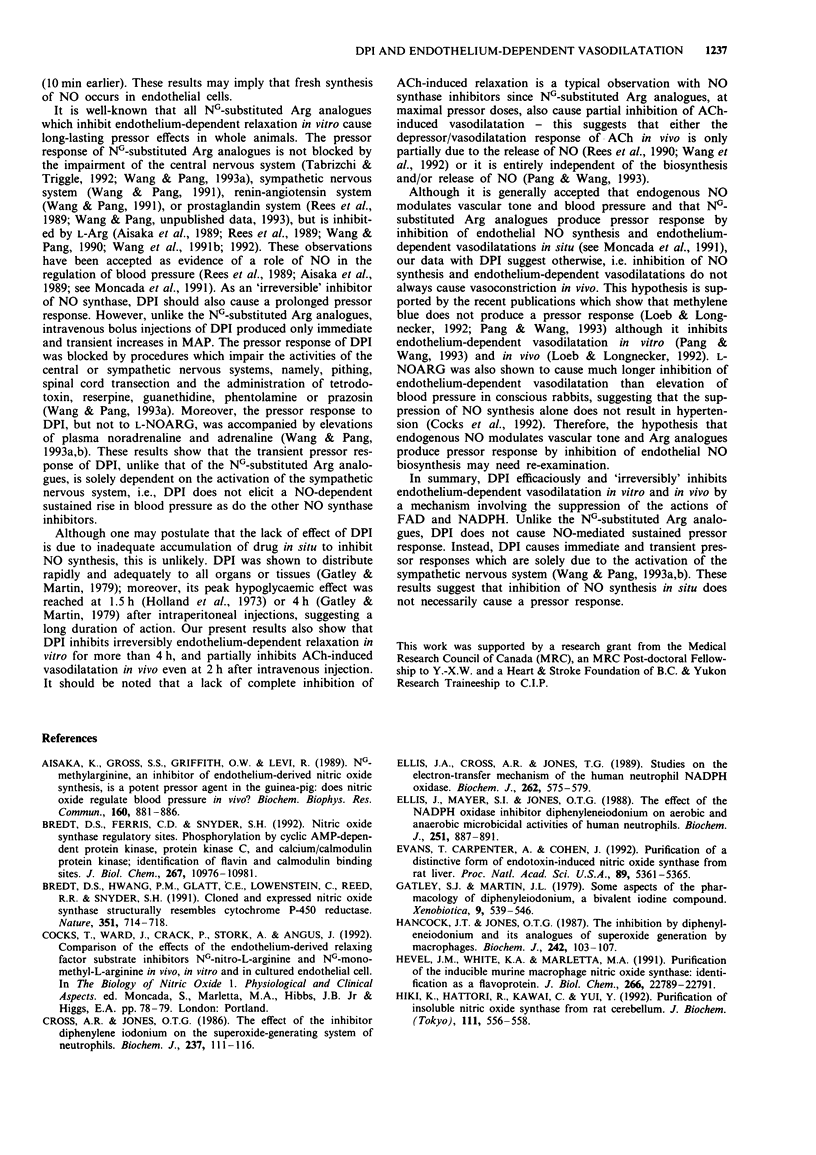
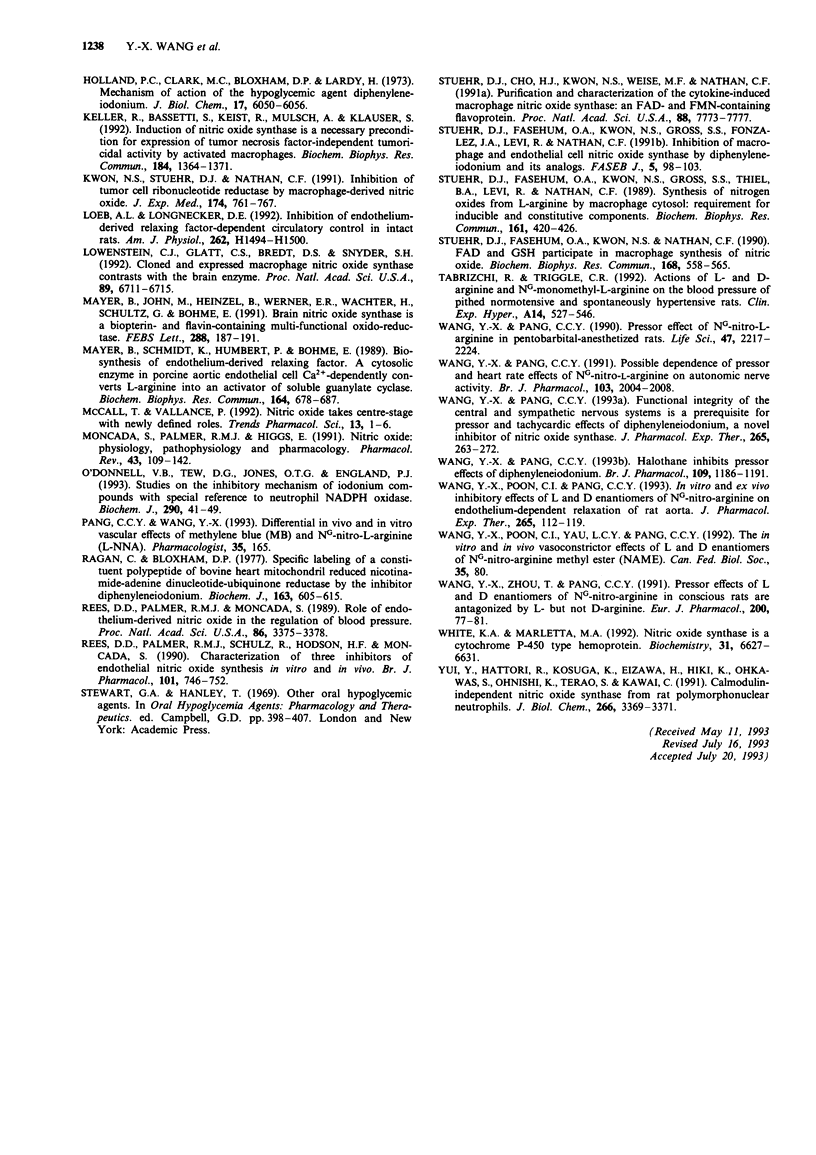
Selected References
These references are in PubMed. This may not be the complete list of references from this article.
- Aisaka K., Gross S. S., Griffith O. W., Levi R. NG-methylarginine, an inhibitor of endothelium-derived nitric oxide synthesis, is a potent pressor agent in the guinea pig: does nitric oxide regulate blood pressure in vivo? Biochem Biophys Res Commun. 1989 Apr 28;160(2):881–886. doi: 10.1016/0006-291x(89)92517-5. [DOI] [PubMed] [Google Scholar]
- Bredt D. S., Ferris C. D., Snyder S. H. Nitric oxide synthase regulatory sites. Phosphorylation by cyclic AMP-dependent protein kinase, protein kinase C, and calcium/calmodulin protein kinase; identification of flavin and calmodulin binding sites. J Biol Chem. 1992 Jun 5;267(16):10976–10981. [PubMed] [Google Scholar]
- Bredt D. S., Hwang P. M., Glatt C. E., Lowenstein C., Reed R. R., Snyder S. H. Cloned and expressed nitric oxide synthase structurally resembles cytochrome P-450 reductase. Nature. 1991 Jun 27;351(6329):714–718. doi: 10.1038/351714a0. [DOI] [PubMed] [Google Scholar]
- Cross A. R., Jones O. T. The effect of the inhibitor diphenylene iodonium on the superoxide-generating system of neutrophils. Specific labelling of a component polypeptide of the oxidase. Biochem J. 1986 Jul 1;237(1):111–116. doi: 10.1042/bj2370111. [DOI] [PMC free article] [PubMed] [Google Scholar]
- Ellis J. A., Cross A. R., Jones O. T. Studies on the electron-transfer mechanism of the human neutrophil NADPH oxidase. Biochem J. 1989 Sep 1;262(2):575–579. doi: 10.1042/bj2620575. [DOI] [PMC free article] [PubMed] [Google Scholar]
- Ellis J. A., Mayer S. J., Jones O. T. The effect of the NADPH oxidase inhibitor diphenyleneiodonium on aerobic and anaerobic microbicidal activities of human neutrophils. Biochem J. 1988 May 1;251(3):887–891. doi: 10.1042/bj2510887. [DOI] [PMC free article] [PubMed] [Google Scholar]
- Evans T., Carpenter A., Cohen J. Purification of a distinctive form of endotoxin-induced nitric oxide synthase from rat liver. Proc Natl Acad Sci U S A. 1992 Jun 15;89(12):5361–5365. doi: 10.1073/pnas.89.12.5361. [DOI] [PMC free article] [PubMed] [Google Scholar]
- Gatley S. J., Martin J. L. Some aspects of the pharmacology of diphenyleneiodonium, a bivalent iodine compound. Xenobiotica. 1979 Sep;9(9):539–546. doi: 10.3109/00498257909042319. [DOI] [PubMed] [Google Scholar]
- Hancock J. T., Jones O. T. The inhibition by diphenyleneiodonium and its analogues of superoxide generation by macrophages. Biochem J. 1987 Feb 15;242(1):103–107. doi: 10.1042/bj2420103. [DOI] [PMC free article] [PubMed] [Google Scholar]
- Hevel J. M., White K. A., Marletta M. A. Purification of the inducible murine macrophage nitric oxide synthase. Identification as a flavoprotein. J Biol Chem. 1991 Dec 5;266(34):22789–22791. [PubMed] [Google Scholar]
- Hiki K., Hattori R., Kawai C., Yui Y. Purification of insoluble nitric oxide synthase from rat cerebellum. J Biochem. 1992 May;111(5):556–558. doi: 10.1093/oxfordjournals.jbchem.a123795. [DOI] [PubMed] [Google Scholar]
- Holland P. C., Clark M. G., Bloxham D. P., Lardy H. A. Mechanism of action of the hypoglycemic agent diphenyleneiodonium. J Biol Chem. 1973 Sep 10;248(17):6050–6056. [PubMed] [Google Scholar]
- Keller R., Bassetti S., Keist R., Mülsch A., Klauser S. Induction of nitric oxide synthase is a necessary precondition for expression of tumor necrosis factor-independent tumoricidal activity by activated macrophages. Biochem Biophys Res Commun. 1992 May 15;184(3):1364–1371. doi: 10.1016/s0006-291x(05)80033-6. [DOI] [PubMed] [Google Scholar]
- Kwon N. S., Stuehr D. J., Nathan C. F. Inhibition of tumor cell ribonucleotide reductase by macrophage-derived nitric oxide. J Exp Med. 1991 Oct 1;174(4):761–767. doi: 10.1084/jem.174.4.761. [DOI] [PMC free article] [PubMed] [Google Scholar]
- Loeb A. L., Longnecker D. E. Inhibition of endothelium-derived relaxing factor-dependent circulatory control in intact rats. Am J Physiol. 1992 May;262(5 Pt 2):H1494–H1500. doi: 10.1152/ajpheart.1992.262.5.H1494. [DOI] [PubMed] [Google Scholar]
- Lowenstein C. J., Glatt C. S., Bredt D. S., Snyder S. H. Cloned and expressed macrophage nitric oxide synthase contrasts with the brain enzyme. Proc Natl Acad Sci U S A. 1992 Aug 1;89(15):6711–6715. doi: 10.1073/pnas.89.15.6711. [DOI] [PMC free article] [PubMed] [Google Scholar]
- Mayer B., John M., Heinzel B., Werner E. R., Wachter H., Schultz G., Böhme E. Brain nitric oxide synthase is a biopterin- and flavin-containing multi-functional oxido-reductase. FEBS Lett. 1991 Aug 19;288(1-2):187–191. doi: 10.1016/0014-5793(91)81031-3. [DOI] [PubMed] [Google Scholar]
- Mayer B., Schmidt K., Humbert P., Böhme E. Biosynthesis of endothelium-derived relaxing factor: a cytosolic enzyme in porcine aortic endothelial cells Ca2+-dependently converts L-arginine into an activator of soluble guanylyl cyclase. Biochem Biophys Res Commun. 1989 Oct 31;164(2):678–685. doi: 10.1016/0006-291x(89)91513-1. [DOI] [PubMed] [Google Scholar]
- McCall T., Vallance P. Nitric oxide takes centre-stage with newly defined roles. Trends Pharmacol Sci. 1992 Jan;13(1):1–6. doi: 10.1016/0165-6147(92)90002-n. [DOI] [PubMed] [Google Scholar]
- Moncada S., Palmer R. M., Higgs E. A. Nitric oxide: physiology, pathophysiology, and pharmacology. Pharmacol Rev. 1991 Jun;43(2):109–142. [PubMed] [Google Scholar]
- O'Donnell B. V., Tew D. G., Jones O. T., England P. J. Studies on the inhibitory mechanism of iodonium compounds with special reference to neutrophil NADPH oxidase. Biochem J. 1993 Feb 15;290(Pt 1):41–49. doi: 10.1042/bj2900041. [DOI] [PMC free article] [PubMed] [Google Scholar]
- Ragan C. I., Bloxham D. P. Specific labelling of a constituent polypeptide of bovine heart mitochondrial reduced nicotinamide-adenine dinucleotide-ubiquinone reductase by the inhibitor diphenyleneiodonium. Biochem J. 1977 Jun 1;163(3):605–615. doi: 10.1042/bj1630605. [DOI] [PMC free article] [PubMed] [Google Scholar]
- Rees D. D., Palmer R. M., Moncada S. Role of endothelium-derived nitric oxide in the regulation of blood pressure. Proc Natl Acad Sci U S A. 1989 May;86(9):3375–3378. doi: 10.1073/pnas.86.9.3375. [DOI] [PMC free article] [PubMed] [Google Scholar]
- Rees D. D., Palmer R. M., Schulz R., Hodson H. F., Moncada S. Characterization of three inhibitors of endothelial nitric oxide synthase in vitro and in vivo. Br J Pharmacol. 1990 Nov;101(3):746–752. doi: 10.1111/j.1476-5381.1990.tb14151.x. [DOI] [PMC free article] [PubMed] [Google Scholar]
- Stuehr D. J., Cho H. J., Kwon N. S., Weise M. F., Nathan C. F. Purification and characterization of the cytokine-induced macrophage nitric oxide synthase: an FAD- and FMN-containing flavoprotein. Proc Natl Acad Sci U S A. 1991 Sep 1;88(17):7773–7777. doi: 10.1073/pnas.88.17.7773. [DOI] [PMC free article] [PubMed] [Google Scholar]
- Stuehr D. J., Fasehun O. A., Kwon N. S., Gross S. S., Gonzalez J. A., Levi R., Nathan C. F. Inhibition of macrophage and endothelial cell nitric oxide synthase by diphenyleneiodonium and its analogs. FASEB J. 1991 Jan;5(1):98–103. doi: 10.1096/fasebj.5.1.1703974. [DOI] [PubMed] [Google Scholar]
- Stuehr D. J., Kwon N. S., Gross S. S., Thiel B. A., Levi R., Nathan C. F. Synthesis of nitrogen oxides from L-arginine by macrophage cytosol: requirement for inducible and constitutive components. Biochem Biophys Res Commun. 1989 Jun 15;161(2):420–426. doi: 10.1016/0006-291x(89)92615-6. [DOI] [PubMed] [Google Scholar]
- Stuehr D. J., Kwon N. S., Nathan C. F. FAD and GSH participate in macrophage synthesis of nitric oxide. Biochem Biophys Res Commun. 1990 Apr 30;168(2):558–565. doi: 10.1016/0006-291x(90)92357-6. [DOI] [PubMed] [Google Scholar]
- Tabrizchi R., Triggle C. R. Actions of L- and D-arginine and NG-monomethyl-L-arginine on the blood pressure of pithed normotensive and spontaneously hypertensive rats. Clin Exp Hypertens A. 1992;14(3):527–546. doi: 10.3109/10641969209036204. [DOI] [PubMed] [Google Scholar]
- Wang Y. X., Pang C. C. Functional integrity of the central and sympathetic nervous systems is a prerequisite for pressor and tachycardic effects of diphenyleneiodonium, a novel inhibitor of nitric oxide synthase. J Pharmacol Exp Ther. 1993 Apr;265(1):263–272. [PubMed] [Google Scholar]
- Wang Y. X., Pang C. C. Halothane inhibits the pressor effect of diphenyleneiodonium. Br J Pharmacol. 1993 Aug;109(4):1186–1191. doi: 10.1111/j.1476-5381.1993.tb13747.x. [DOI] [PMC free article] [PubMed] [Google Scholar]
- Wang Y. X., Pang C. C. Possible dependence of pressor and heart rate effects of NG-nitro-L-arginine on autonomic nerve activity. Br J Pharmacol. 1991 Aug;103(4):2004–2008. doi: 10.1111/j.1476-5381.1991.tb12367.x. [DOI] [PMC free article] [PubMed] [Google Scholar]
- Wang Y. X., Pang C. C. Pressor effect of NG-nitro-L-arginine in pentobarbital-anesthetized rats. Life Sci. 1990;47(24):2217–2224. doi: 10.1016/0024-3205(90)90152-h. [DOI] [PubMed] [Google Scholar]
- Wang Y. X., Poon C. I., Pang C. C. In vitro and ex vivo inhibitory effects of L- and D-enantiomers of NG-nitro-arginine on endothelium-dependent relaxation of rat aorta. J Pharmacol Exp Ther. 1993 Apr;265(1):112–119. [PubMed] [Google Scholar]
- Wang Y. X., Zhou T., Pang C. C. Pressor effects of L and D enantiomers of NG-nitro-arginine in conscious rats are antagonized by L- but not D-arginine. Eur J Pharmacol. 1991 Jul 23;200(1):77–81. doi: 10.1016/0014-2999(91)90668-g. [DOI] [PubMed] [Google Scholar]
- White K. A., Marletta M. A. Nitric oxide synthase is a cytochrome P-450 type hemoprotein. Biochemistry. 1992 Jul 28;31(29):6627–6631. doi: 10.1021/bi00144a001. [DOI] [PubMed] [Google Scholar]
- Yui Y., Hattori R., Kosuga K., Eizawa H., Hiki K., Ohkawa S., Ohnishi K., Terao S., Kawai C. Calmodulin-independent nitric oxide synthase from rat polymorphonuclear neutrophils. J Biol Chem. 1991 Feb 25;266(6):3369–3371. [PubMed] [Google Scholar]


